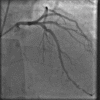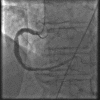Brugada pattern: a comprehensive review on the demographic and clinical spectrum
- PMID: 31300599
- PMCID: PMC6626482
- DOI: 10.1136/bcr-2019-229829
Brugada pattern: a comprehensive review on the demographic and clinical spectrum
Abstract
A prominent coved or saddle-shaped ST-segment elevation followed by T wave changes in V1-V3 and in the absence of other identifiable cause is termed as Brugada pattern. This pattern in the presence of documented ventricular arrhythmias or its symptoms (syncope, seizure) or significant family for sudden cardiac death or abovementioned ECG changes is called Brugada syndrome. Here we present a comprehensive literature review on the precipitation factors of Brugada syndrome/pattern by various stimuli, its presentation, associations, management and outcomes. We are also presenting a unique case of Brugada pattern where the patient's Brugada pattern was unmasked at an extreme old age by infection.
Keywords: arrhythmias; cardiovascular medicine.
© BMJ Publishing Group Limited 2019. No commercial re-use. See rights and permissions. Published by BMJ.
Conflict of interest statement
Competing interests: None declared.
Figures





Similar articles
-
[Doubts of the cardiologist regarding an electrocardiogram presenting QRS V1-V2 complexes with positive terminal wave and ST segment elevation. Consensus Conference promoted by the Italian Cardiology Society].G Ital Cardiol (Rome). 2010 Nov;11(11 Suppl 2):3S-22S. G Ital Cardiol (Rome). 2010. PMID: 21361048 Italian.
-
A Case of Type I and II Brugada Phenocopy Unmasked in a Patient with Normal Baseline Electrocardiogram (ECG).Am J Case Rep. 2018 Jan 5;19:21-24. doi: 10.12659/ajcr.906464. Am J Case Rep. 2018. PMID: 29302023 Free PMC article.
-
[Brugada syndrome--a rare cause of syncope and sudden death].Lakartidningen. 2015 Nov 24;112:DRFP. Lakartidningen. 2015. PMID: 26660962 Swedish.
-
[Brugada syndrome: case report].Srp Arh Celok Lek. 2012 Jan-Feb;140(1-2):84-90. doi: 10.2298/sarh1202084b. Srp Arh Celok Lek. 2012. PMID: 22462353 Serbian.
-
Clinical approach to the patient with Brugada Syndrome: risk stratification and optimal management.Panminerva Med. 2019 Dec;61(4):473-485. doi: 10.23736/S0031-0808.19.03736-4. Epub 2019 Sep 6. Panminerva Med. 2019. PMID: 31508925 Review.
Cited by
-
A rare case with melatonin-induced on top of alcohol intoxication Brugada type 2 pattern.Clin Case Rep. 2023 Nov 16;11(11):e8245. doi: 10.1002/ccr3.8245. eCollection 2023 Nov. Clin Case Rep. 2023. PMID: 38028063 Free PMC article.
-
Brugada Phenotype Following a Cocaine Overdose.Cureus. 2024 Jul 4;16(7):e63861. doi: 10.7759/cureus.63861. eCollection 2024 Jul. Cureus. 2024. PMID: 39099899 Free PMC article.
-
Fever Unmasking Brugada-Pattern Electrocardiogram in Patient With Coronavirus Disease 2019 (COVID-19).J Emerg Med. 2020 Sep;59(3):439-441. doi: 10.1016/j.jemermed.2020.06.053. Epub 2020 Jun 13. J Emerg Med. 2020. PMID: 32739128 Free PMC article. No abstract available.
-
Long-Term Prognosis of Febrile Individuals with Right Precordial Coved-Type ST-Segment Elevation Brugada Pattern: A 10-Year Prospective Follow-Up Study.J Clin Med. 2021 Oct 27;10(21):4997. doi: 10.3390/jcm10214997. J Clin Med. 2021. PMID: 34768515 Free PMC article.
References
Publication types
MeSH terms
Substances
LinkOut - more resources
Full Text Sources
Medical
